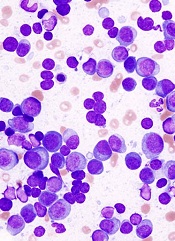User login

The National Comprehensive Cancer Network (NCCN) has revised its clinical practice guidelines on multiple myeloma (MM) to include response criteria developed by the International Myeloma Working Group (IMWG) and testing for minimal residual disease (MRD).
The NCCN develops practice guidelines to help physicians in making informed treatment decisions.
Its recommendations can facilitate reimbursement for testing or treatment.
“The NCCN’s action represents a further step toward broad use of MRD testing,” said Brian Durie, MD, chairman of the International Myeloma Foundation (IMF).
The importance of first identifying and then eliminating MRD is the key principle of the IMF’s Black Swan Research Initiative®, a collaborative effort launched in 2012 to cure MM.
“We’ve long believed early intervention with highly effective treatments is the pathway to curing myeloma, and we are currently testing this in clinical trials,” Dr Durie said.
Through the Black Swan Research Initiative, the IMF helped develop next-generation flow cytometry, 1 of 2 tests recommended by the NCCN to assess the presence of MRD in MM patients. The second test is next-generation sequencing.
The new MM response criteria, on which the NCCN based its most recent revision to the guidelines, were developed and agreed upon by the more than 200 members of the IMWG.
The new response criteria spell out exact definitions of “MRD negative” by next-generation flow cytometry or next-generation sequencing.
“We are pleased that the 2016 IMWG response criteria were adopted in full in the new NCCN recommendations,” said Shaji Kumar, MD, of the Mayo Clinic in Rochester, Minnesota.
The 2016 IMWG response criteria were published in The Lancet Oncology in August. ![]()

The National Comprehensive Cancer Network (NCCN) has revised its clinical practice guidelines on multiple myeloma (MM) to include response criteria developed by the International Myeloma Working Group (IMWG) and testing for minimal residual disease (MRD).
The NCCN develops practice guidelines to help physicians in making informed treatment decisions.
Its recommendations can facilitate reimbursement for testing or treatment.
“The NCCN’s action represents a further step toward broad use of MRD testing,” said Brian Durie, MD, chairman of the International Myeloma Foundation (IMF).
The importance of first identifying and then eliminating MRD is the key principle of the IMF’s Black Swan Research Initiative®, a collaborative effort launched in 2012 to cure MM.
“We’ve long believed early intervention with highly effective treatments is the pathway to curing myeloma, and we are currently testing this in clinical trials,” Dr Durie said.
Through the Black Swan Research Initiative, the IMF helped develop next-generation flow cytometry, 1 of 2 tests recommended by the NCCN to assess the presence of MRD in MM patients. The second test is next-generation sequencing.
The new MM response criteria, on which the NCCN based its most recent revision to the guidelines, were developed and agreed upon by the more than 200 members of the IMWG.
The new response criteria spell out exact definitions of “MRD negative” by next-generation flow cytometry or next-generation sequencing.
“We are pleased that the 2016 IMWG response criteria were adopted in full in the new NCCN recommendations,” said Shaji Kumar, MD, of the Mayo Clinic in Rochester, Minnesota.
The 2016 IMWG response criteria were published in The Lancet Oncology in August. ![]()

The National Comprehensive Cancer Network (NCCN) has revised its clinical practice guidelines on multiple myeloma (MM) to include response criteria developed by the International Myeloma Working Group (IMWG) and testing for minimal residual disease (MRD).
The NCCN develops practice guidelines to help physicians in making informed treatment decisions.
Its recommendations can facilitate reimbursement for testing or treatment.
“The NCCN’s action represents a further step toward broad use of MRD testing,” said Brian Durie, MD, chairman of the International Myeloma Foundation (IMF).
The importance of first identifying and then eliminating MRD is the key principle of the IMF’s Black Swan Research Initiative®, a collaborative effort launched in 2012 to cure MM.
“We’ve long believed early intervention with highly effective treatments is the pathway to curing myeloma, and we are currently testing this in clinical trials,” Dr Durie said.
Through the Black Swan Research Initiative, the IMF helped develop next-generation flow cytometry, 1 of 2 tests recommended by the NCCN to assess the presence of MRD in MM patients. The second test is next-generation sequencing.
The new MM response criteria, on which the NCCN based its most recent revision to the guidelines, were developed and agreed upon by the more than 200 members of the IMWG.
The new response criteria spell out exact definitions of “MRD negative” by next-generation flow cytometry or next-generation sequencing.
“We are pleased that the 2016 IMWG response criteria were adopted in full in the new NCCN recommendations,” said Shaji Kumar, MD, of the Mayo Clinic in Rochester, Minnesota.
The 2016 IMWG response criteria were published in The Lancet Oncology in August. ![]()